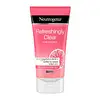What's inside
What's inside
 Key Ingredients
Key Ingredients

 Benefits
Benefits

 Concerns
Concerns

 Ingredients Side-by-side
Ingredients Side-by-side

Water
Skin ConditioningGlycerin
HumectantSodium Laureth Sulfate
CleansingLauryl Glucoside
CleansingAcrylates/C10-30 Alkyl Acrylate Crosspolymer
Emulsion StabilisingCitrus Grandis Fruit Extract
AstringentPropylene Glycol
HumectantSodium Benzotriazolyl Butylphenol Sulfonate
UV AbsorberDisodium EDTA
Citric Acid
BufferingSodium Hydroxide
BufferingSodium Ascorbyl Phosphate
AntioxidantSodium Benzoate
MaskingParfum
MaskingCI 16035
Cosmetic ColorantCI 60725
Cosmetic ColorantWater, Glycerin, Sodium Laureth Sulfate, Lauryl Glucoside, Acrylates/C10-30 Alkyl Acrylate Crosspolymer, Citrus Grandis Fruit Extract, Propylene Glycol, Sodium Benzotriazolyl Butylphenol Sulfonate, Disodium EDTA, Citric Acid, Sodium Hydroxide, Sodium Ascorbyl Phosphate, Sodium Benzoate, Parfum, CI 16035, CI 60725
Water
Skin ConditioningSodium Laureth Sulfate
CleansingDecyl Glucoside
CleansingCocamidopropyl Betaine
CleansingGlycerin
HumectantPEG-55 Propylene Glycol Oleate
Propylene Glycol
HumectantSodium Chloride
MaskingPanthenol
Skin ConditioningPEG-7 Glyceryl Cocoate
EmulsifyingPhenoxyethanol
PreservativeGlycol Distearate
EmollientTocopheryl Acetate
AntioxidantPolyquaternium-39
Cocamide Mea
EmulsifyingLaureth-10
EmulsifyingDisodium EDTA
Sodium Benzoate
MaskingHydroxypropyl Cyclodextrin
MaskingPantolactone
HumectantBenzoic Acid
MaskingBisabolol
MaskingIodopropynyl Butylcarbamate
PreservativeWater, Sodium Laureth Sulfate, Decyl Glucoside, Cocamidopropyl Betaine, Glycerin, PEG-55 Propylene Glycol Oleate, Propylene Glycol, Sodium Chloride, Panthenol, PEG-7 Glyceryl Cocoate, Phenoxyethanol, Glycol Distearate, Tocopheryl Acetate, Polyquaternium-39, Cocamide Mea, Laureth-10, Disodium EDTA, Sodium Benzoate, Hydroxypropyl Cyclodextrin, Pantolactone, Benzoic Acid, Bisabolol, Iodopropynyl Butylcarbamate
 Reviews
Reviews

Ingredients Explained
These ingredients are found in both products.
Ingredients higher up in an ingredient list are typically present in a larger amount.
Disodium EDTA plays a role in making products more stable by aiding other preservatives.
It is a chelating agent, meaning it neutralizes metal ions that may be found in a product.
Disodium EDTA is a salt of edetic acid and is found to be safe in cosmetic ingredients.
Learn more about Disodium EDTAGlycerin is already naturally found in your skin. It helps moisturize and protect your skin.
A study from 2016 found glycerin to be more effective as a humectant than AHAs and hyaluronic acid.
As a humectant, it helps the skin stay hydrated by pulling moisture to your skin. The low molecular weight of glycerin allows it to pull moisture into the deeper layers of your skin.
Hydrated skin improves your skin barrier; Your skin barrier helps protect against irritants and bacteria.
Glycerin has also been found to have antimicrobial and antiviral properties. Due to these properties, glycerin is often used in wound and burn treatments.
In cosmetics, glycerin is usually derived from plants such as soybean or palm. However, it can also be sourced from animals, such as tallow or animal fat.
This ingredient is organic, colorless, odorless, and non-toxic.
Glycerin is the name for this ingredient in American English. British English uses Glycerol/Glycerine.
Learn more about GlycerinPropylene Glycol is an odorless, colorless liquid. As a humectant, it helps skin retain moisture. It also aids in delivering active ingredients.
Another role of this ingredient is preventing a product from melting or freezing. Propylene glycol also adds antimicrobrial properties to a product, elongating product lifespan.
This ingredient is considered an organic alcohol and commonly added into both cosmetics and foods.
Those with sensitive skin or conditions may develop a rash when using this ingredient.
Learn more about Propylene GlycolSodium Benzoate is a preservative. It's used in both cosmetic and food products to inhibit the growth of mold and bacteria. It is typically produced synthetically.
Both the US FDA and EU Health Committee have approved the use of sodium benzoate. In the US, levels of 0.1% (of the total product) are allowed.
Sodium benzoate works as a preservative by inhibiting the growth of bacteria inside of cells. It prevents the cell from fermenting a type of sugar using an enzyme called phosphofructokinase.
It is the salt of benzoic acid. Foods containing sodium benzoate include soda, salad dressings, condiments, fruit juices, wines, and snack foods.
Studies for using ascorbic acid and sodium benzoate in cosmetics are lacking, especially in skincare routines with multiple steps.
We always recommend speaking with a professional, such as a dermatologist, if you have any concerns.
Learn more about Sodium BenzoateSodium Laureth Sulfate (SLES) is a foaming, cleansing, and emulsifying ingredient. It is created from palm kernel oil or coconut oil. SLES is not the same as sodium lauryl sulfate. It is much milder and less likely to irritate.
SLES helps create foam in personal products. It also prevents ingredients from separating, helping to elongate the shelf life.
Sodium Laureth Sulfate is a type of sulfate. It can be drying. We recommend speaking with a professional about using this ingredient if you have concerns.
Learn more about Sodium Laureth SulfateWater. It's the most common cosmetic ingredient of all. You'll usually see it at the top of ingredient lists, meaning that it makes up the largest part of the product.
So why is it so popular? Water most often acts as a solvent - this means that it helps dissolve other ingredients into the formulation.
You'll also recognize water as that liquid we all need to stay alive. If you see this, drink a glass of water. Stay hydrated!
Learn more about Water